Abstract
Horseshoe crabs, Limulus polyphemus, are the preferred bait in the eel and conch fisheries along the east coast of the United States. However, recent management measures have restricted the availability of horseshoe crabs to commercial fisheries, creating the need for sustainable, alternative bait sources. In this study, we examined the chemistry underlying the predator– prey attraction to determine if specific, isolable attractant metabolites from the horseshoe crab could be identified and characterized for incorporation into an artifical bait. Initial assays with the mud snail, Ilyanassa obsoleta, suggested that the chemoattractants were concentrated in L. polyphemus eggs. Chemical analyses and biological assays of the egg extract indicated the primary cue was a heat-stable, proteinaceous compound (>10 kDa). A carbohydrate-rich fraction of low molecular mass (<10 kDa) also enhanced mud snail chemotaxis. Analysis of egg digests with SDS-PAGE confirmed the presence of glycoproteins or carbohydrate-binding proteins in the horseshoe crab egg extract. Because the attractant appears to be a complex protein or glycoprotein, conventional chemical synthesis is unlikely. However, the tools of modern biotechnology offer the potential to produce this attractant in a system independent of the horseshoe crab. Such an attractant could be incorporated into an artificial bait, providing an ecologically sound alternative for commercial eel and whelk fisheries.
Similar content being viewed by others
Author information
Authors and Affiliations
Corresponding author
Rights and permissions
About this article
Cite this article
Ferrari, K.M., Targett, N.M. Chemical Attractants in Horseshoe Crab, Limulus polyphemus, Eggs: The Potential for an Artificial Bait. J Chem Ecol 29, 477–496 (2003). https://doi.org/10.1023/A:1022698431776
Issue Date:
DOI: https://doi.org/10.1023/A:1022698431776




